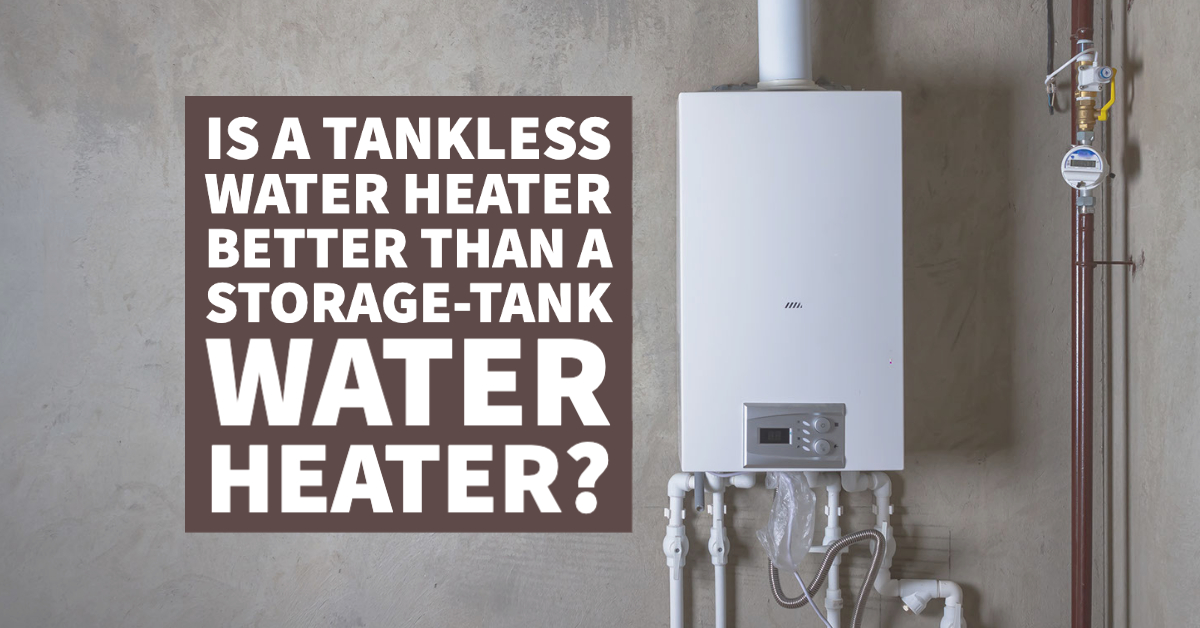When it comes to showering or removing grime and dirt from laundry, hot water is such an essential part of your home. However, since hot water comes from a water heater, you might wonder if it’s better to install a tankless water heater or a model using a storage tank. In the following, our experts at Bellbrook Plumbing & Drain compare the two types of water heaters and explain what you need to know to make the best and most informed decision.
Tankless Water Heater vs. Tank Water Heaters
The average cost to install a new water heater with a storage tank is usually somewhere between $825 and $1,700. If you look at the average, most customers can expect to pay about $1,500 for parts and labor for a traditional water heater. Tankless water heaters, on the other hand, usually cost more than the traditional units, which heat water and keep it heated in a storage tank. Tankless water heater installation has an average cost of somewhere between $1,000 to $3,000.
On average, traditional water heaters cost $300 to $2,000 in parts for the tank alone. For labor costs of a professional plumber, you can expect to pay at least $50 per hour. Therefore, we strongly advise hiring a professional like Bellbrook Plumbing & Drain for water heater installation. When it comes to labor costs and the installation of a tankless water heater compared to the labor costs of installing a tank-style heater, you pay more in labor for a tankless model. This additional cost, nevertheless, is compensated for by the decrease in water heating costs each month.
Water heaters account for around 20% of home energy consumption. If you have a tank water heater, it’s always a lot higher because the storage tank keeps the water hot around the clock, whereas on-demand water heaters heat the water when needed.
What Is a Tankless Water Heater?
As noted above, tankless water heaters are also called on-demand water heaters. Tankless water heaters consistently deliver hot water to your home or business, no matter what your usage needs might be. They are usually fueled by electricity or gas. They use high-powered burners to heat the tap water to desired levels quickly, and they transfer it through a heat exchanger before sending it to your faucets or shower. Because they heat the water on demand, only as needed, they don’t need to store it in a tank. Tankless water heaters are usually powered with electricity or gas. In the following, we examine both types:
Electric-Powered Tankless Water Heaters
Electric tankless water heaters usually cost less to install than gas-powered models. On average, electric water heaters usually cost between $800 to $1,500 for their installation. Their lower cost to install reflects the fact that the installation job is a much easier one to perform. In addition, electric water heaters don’t require evasive venting like their gas counterparts. They are less dangerous, in general, because you aren’t dealing with gas. Nevertheless, some of the common complaints we get about electric-powered heaters are slow heating times and higher utility costs.
Gas-Powered Tankless Water Heaters
For propane or natural gas-powered tankless water heaters, you can expect to pay between $1,000 to $1,500 for installation. If your home or building is located close to a natural gas line, you are in luck. It’s going to be easy to tap into existing gas lines (which we might be required to do). In any case, you will have to purchase propane on your own if you don’t have natural gas in your area.
What Are Tank Water Heaters?
Water heaters that have a storage tank are categorized as traditional water heaters. These water heaters are still the water heater being used in about 90 percent of the homes in the U.S. One of the most significant differences between a tankless water heater, and a storage-tank water heater is the need for their large water tank. These water storage tanks require a lot of space in the home. Many of them hold as much as 40 to 120 gallons of water, which is kept heated. With a traditional water heater, a pipe leads from the top of the water tank to your faucets.
Similar to a tankless water heater, traditional water heaters need either natural gas or electricity to use for their heating capacity.
The Pros and Cons of Both
The advantages of a traditional water heater are that they are less expensive to install, they can heat large amounts of water and store it for when it’s needed, and they are simple to repair. The disadvantages of a tank water heater include their need for storage space, they don’t last as long as the new tankless counterparts, and they cost more each month on your utility bill because it’s constantly heating water.
Advantages of a tankless water heater include the fact that they don’t need as much space, they are very energy efficient, and they heat water quickly. The disadvantages include their expensive installation costs, which can require retrofitting, which we at Bellbrook Plumbing & Drain can perform, they are quick to run out of hot water, and their maintenance and repair costs can be higher.
Are you ready to install a new water heater?
Whether you’re looking to install a tank water heater or a tankless water heater for your home or business in Fairborn, Greater Dayton, or Greater Cincinnati, your hot water heater experts at Bellbrook Plumbing & Drain are always available to help.
Give us a call today at (937) 240-3731 or schedule an appointment online now by clicking here!

